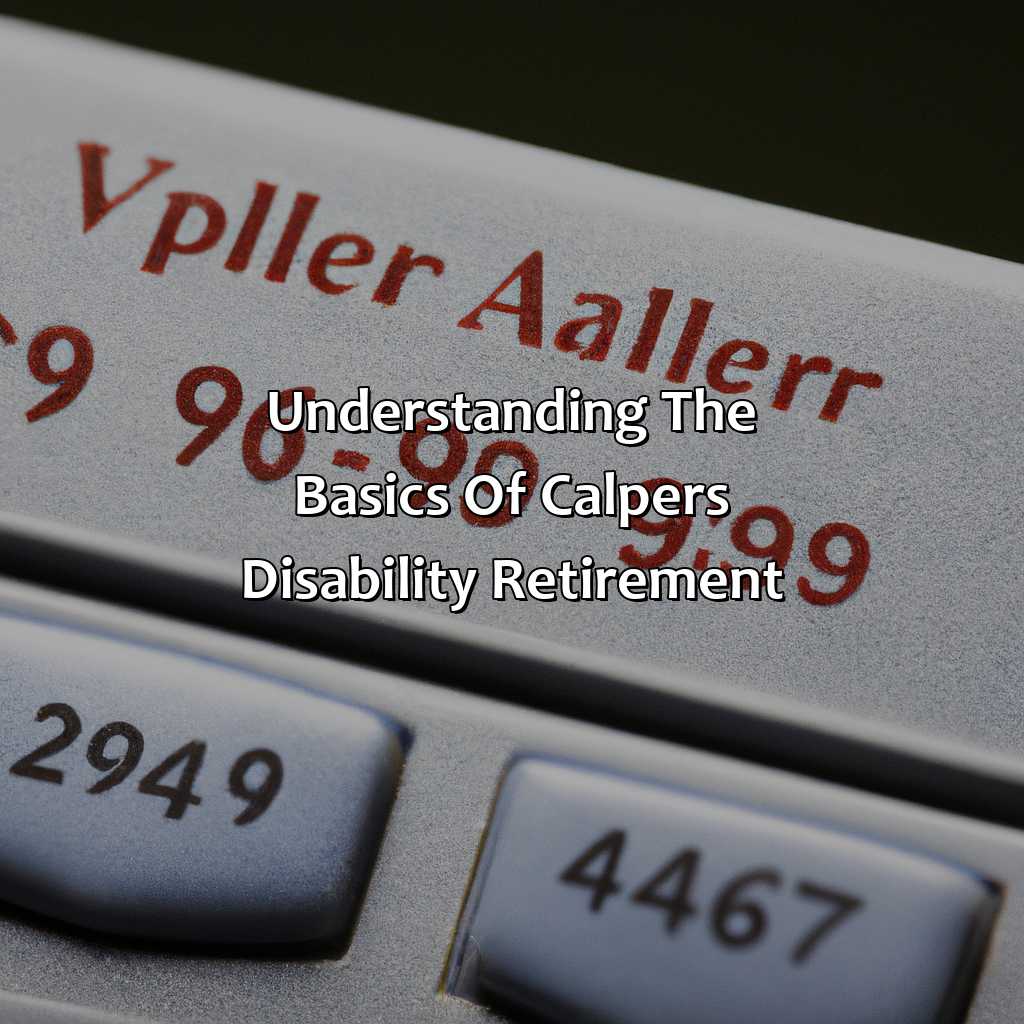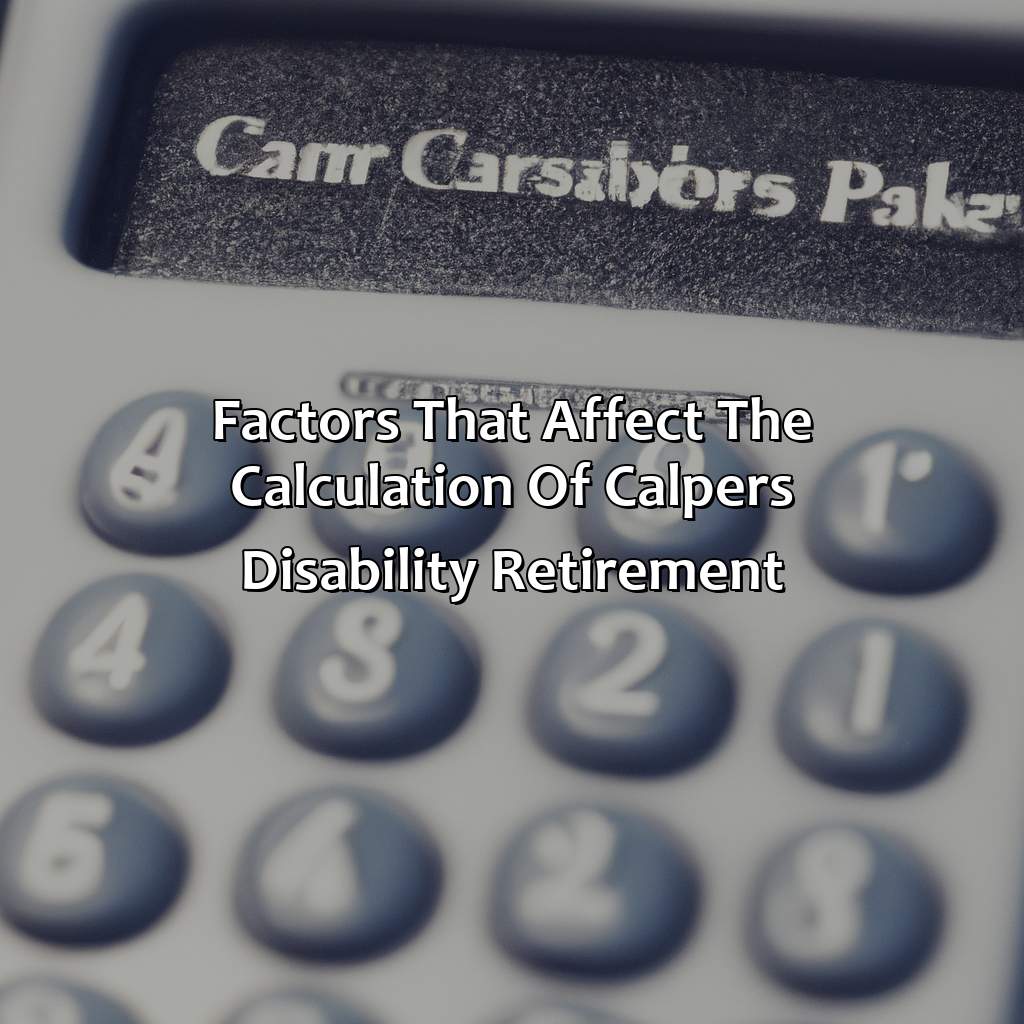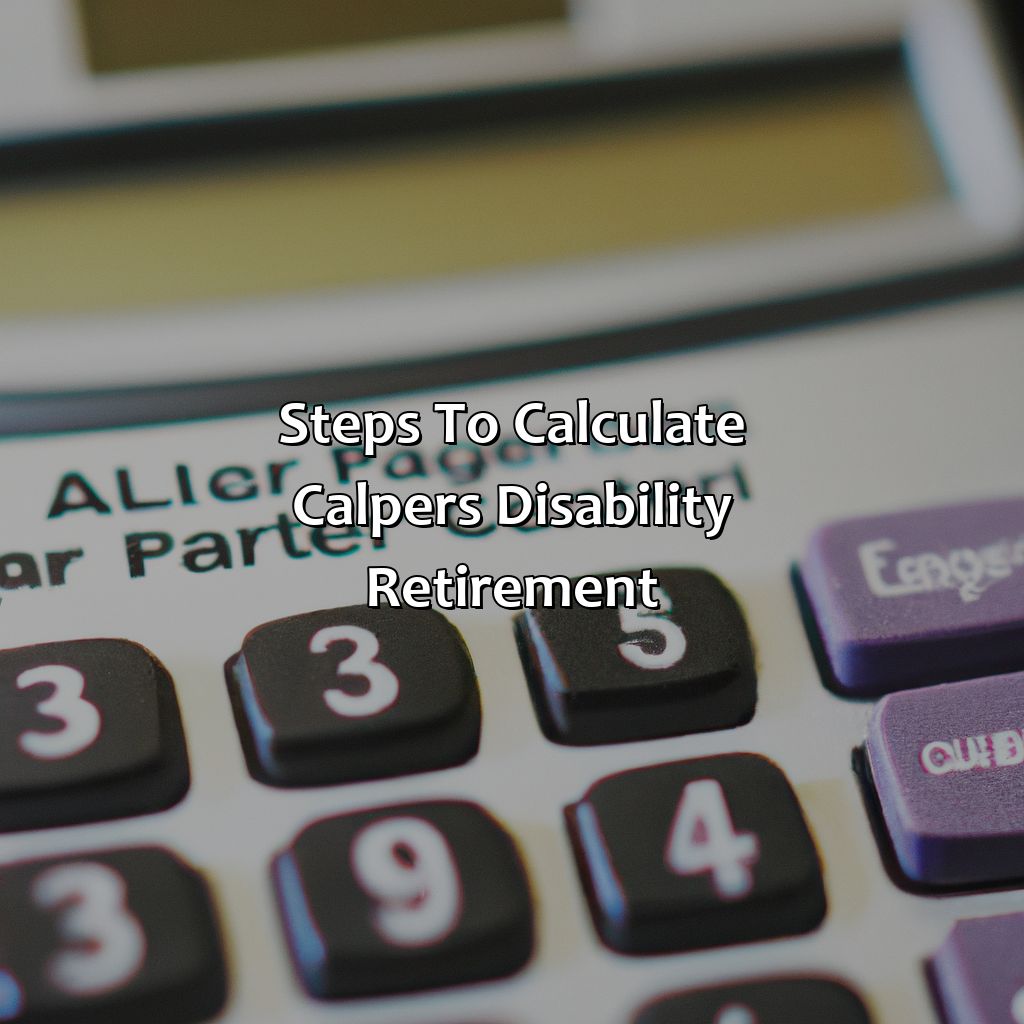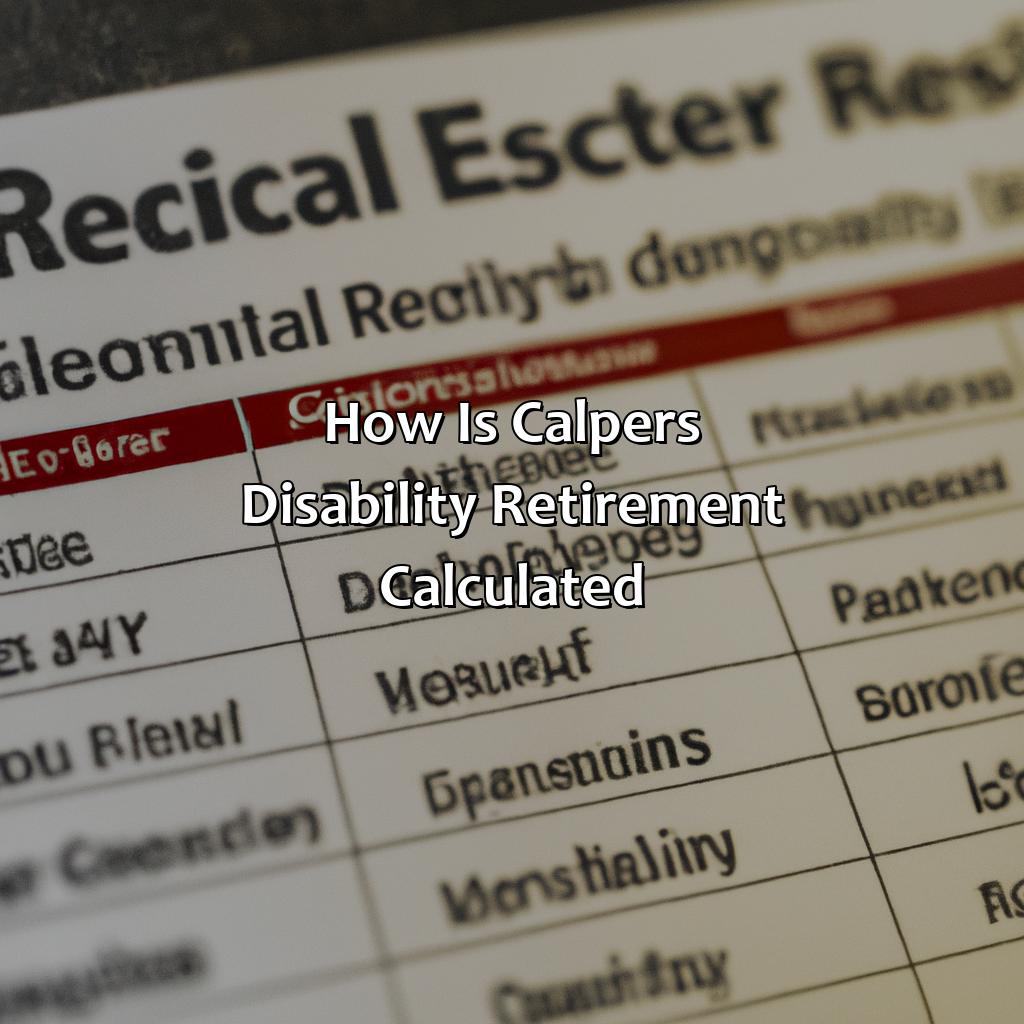How Is Calpers Disability Retirement Calculated?
Key Takeaway:
- CalPERS disability retirement benefits are calculated based on the employee’s service credit, average final compensation (AFC), and benefit factor. The formula used is: service credit x AFC x benefit factor = monthly benefit.
- Eligibility for CalPERS disability retirement requires a member to have at least five years of service credit, be unable to perform their job due to a mental or physical disability, and have exhausted all leave options. The disability must be likely to be permanent, and the member must provide medical evidence of their disability.
- Calculating your AFC involves determining the average of your highest-paid consecutive 12, 36, or 60 months of compensation. The benefit factor varies based on your age at disability retirement and type of retirement option selected. Lastly, taxes may impact your disability retirement benefit, as some payments may be taxable while others are not.
Have you been considering applying for CalPERS Disability Retirement? Knowing how your disability retirement benefit is calculated can help you make the best decision for your financial future. You’ll learn all you need to know in this comprehensive guide.
Understanding the Basics of CalPERS Disability Retirement
Learn the basics of CalPERS disability retirement! Know the criteria for eligibility. Calculate the benefits. Familiarize yourself with the types of disability retirement. This section will aid you in comprehending these concepts. Have a clear understanding of how CalPERS computes disability retirement benefits.

Image credits: retiregenz.com by Joel Duncun
Eligibility Criteria for CalPERS Disability Retirement
To qualify for CalPERS Disability Retirement, an employee must have become permanently incapacitated and unable to perform their job duties due to a service-related or non-service-related illness or injury. Additionally, the disability must prevent the employee from performing their job without any reasonable accommodation, and all other available leave options must have been exhausted.
Furthermore, the employee must be under the retirement age and have at least five years of creditable service in a retirement system. The application process must be completed within one year of leaving employment, and the employee’s treating physician must certify that they are unable to work.
It is important to keep in mind that each application is unique and weighed on a case-by-case basis. Several factors including medical evidence, job description, and individual circumstances determine if an employee meets eligibility criteria.
To increase their chances of approval, employees should ensure that all required documentation is complete and provided accurately as part of the application. It can also be helpful to seek legal representation or assistance from a qualified attorney.
Employees should also be aware that CalPERS offers two different types of disability retirement benefits: Industrial Disability Retirement (IDR) which covers injuries or illnesses suffered as a result of employment activities; and Non-Industrial Disability Retirement (NIDR), which covers disabilities not related to work itself.
Understanding the eligibility criteria for CalPERS Disability Retirement can help ensure employees are adequately prepared when seeking these benefits. Following the guidelines mentioned above could prove vital in navigating this process successfully.
Calculating disability retirement benefits is like solving a math problem with real-life consequences – except you can’t just use a calculator.
Calculation of Disability Retirement Benefits
When calculating one’s CalPERS disability retirement benefits, multiple factors come into play. The first factor is the length of service credit, which determines the percentage of the final compensation that is paid out. The second factor involves determining one’s age at the time of retirement.
Here is a table to help illustrate how these factors work together:
| Service Credit Years | Percentage Formula |
|---|---|
| Less than 5 years | 1.25% x Service Credit x Final Compensation |
| 5 years or more but less than 10 years | 2% x Service Credit x Final Compensation |
| 10 years or more but less than 20 years | 2.5% x Service Credit x Final Compensation |
| 20 years or more (any age) | 2.7% x Service Credit x Final Compensation |
It’s important to note that regardless of one’s age or service credit, CalPERS will not pay more than 90 percent of the member’s highest average annual compensation earnable (HACE) during a consecutive 12-month period.
Additionally, other factors such as whether the member elected a joint and survivor allowance option or if they have eligible dependents can also affect their disability retirement benefits.
Ultimately, understanding how CalPERS calculates disability retirement benefits is crucial for individuals considering this option. Failing to plan can result in missed opportunities and financial insecurity in retirement. Take time to assess your options and make informed decisions about your future finances.
Disabilities can come in all shapes and sizes, just like retirement plans – CalPERS has got you covered.
Types of Disability Retirement
There are different variations of CalPERS Disability Retirement that one needs to be aware of when considering this option. Listed below are the classifications and details of each:
- Industrial Disability Retirement (IDR): For those who have sustained or obtained a job-related injury or illness that would prevent them from returning to their previous position.
- Non-Industrial Disability Retirement (NIDR): For those who have an injury or illness that is non-job related but continues to restrict them from performing their job duties.
- State Safety Miscellaneous (SSM): For safety members designated within the state government, such as police officers, firefighters, rangers etc., whose work environment comes with potential hazards they are exposed to.
- Laborers Pension Fund and Construction Laborers Pension Plan: Disabled unionized employees can apply for disability retirement under these pension plans outside the CalPERS system.
- CERBT Disability Retirement: Members employed before January 1, 1986 in cities with fewer than 2,000 constituents have this separate plan through CalPERS which doesn’t follow all the provisions applicable under State Members CERP plan.
It is essential to note that while some key differences exist between these types there are also general eligibility criteria one must fulfill; have made contributory payments towards their pension system for at least five years if a local agency member and ten years if a state agency member.
It’s crucial to understand that there may be additional requirements beyond these constraints according to each class of disability retirement applied for.
According to the Employee Benefits Institute of America(EBCI), about 3.5% of State Employees received benefits through CalPERS in 2017.
Calculating CalPERS disability retirement is like playing a game of 20 questions, but instead of guessing an object, you’re guessing the factors that affect the calculation.
Factors that Affect the Calculation of CalPERS Disability Retirement
To figure your CalPERS disability retirement, multiple things must be taken into account. The essential components that decide the amount of your CalPERS disability retirement benefits are:
- Service credit
- Average final compensation (AFC)
- Benefit factor
- Taxes
Knowing these elements is necessary for correctly estimating your disability retirement benefits.

Image credits: retiregenz.com by David Woodhock
Service Credit
The credit that an individual earns while working in a public service position is calculated as Public Services Credit or PSC. This is crucial in determining the retirement benefits for CalPERS (California Public Employees’ Retirement System) members. The number of years worked, the level of compensation, and the employment category determine PSC.
Moreover, different types of work and leave periods may impact service credits. For instance, individuals who work part-time accrue fewer credits than their full-time counterparts. Similarly, military leaves often count towards service credit if they are less than five years; otherwise, they do not earn any retirement credit.
Additionally, unused sick leave may be included in service credit calculations for most employees who joined on or after January 1, 2013. On the other hand, excess vacation is not considered for most new hires hired before January 1, 2018.
It is essential to note that the calculation and application of PSC vary based on employment types such as state and non-state public agencies or school districts.
One employee shared a story where they took an approved leave of absence equivalent to two months which resulted in a loss of one-third month’s worth of credit for each year that they had been employed with the county. They learned that non-statutory leaves have detrimental effects on service credits and planned their future appropriately accordingly to avoid losing any future benefits.
Your AFC may determine your retirement income, but don’t worry, if you’re ever in doubt just throw a few extra zeros in there.
Average Final Compensation (AFC)
The calculation of the average amount earned in a certain period called “Average Final Compensation” (AFC) is an essential factor in the CalPERS disability retirement formula. The AFC determines the monthly benefit amount a member will receive when retiring. It’s calculated based on the average output of a member during their last three working years before leaving service.
AFC
| Year | Earnings |
|---|---|
| Year 1 | $60,000 |
| Year 2 | $70,000 |
| Year 3 | $80,000 |
To calculate AFC:
- Add together all three-year earnings: $210,000.
- Divide the total by 36 months: $5,833 monthly average then rounded to $5,834 for benefits calculation.
It’s important to note that not all forms of compensation are included while calculating AFC. For example, bonuses or compensations paid out of state service are not considered.
It’s worth noting that even if an individual can’t remember specific numbers from their payroll history without error, they can still submit potential documentation to assist CalPERS in reviewing and validating these figures. Or else a reason for stay in point and such related documents may help in the calculation process.
The calculation of Average Final Compensation has undergone several changes over time. But presently it is calculated as described above based on provisions established by legislation that passed as part of AB 340 (2012).
Why settle for just a regular retirement when you can add some disability into the mix? Enter the mysterious world of CalPERS Disability Retirement benefit factors.
Benefit Factor
The Benefit Factor is a crucial element that influences the calculation of CalPERS Disability Retirement compensation. Below are three vital points that detail how this factor affects your retirement benefit calculations:
- Benefit Factor is determined by the member’s age, service credits, and retirement formula.
- The Benefit Factor affects the amount of your monthly retirement benefit as it defines the percentage used to calculate your pension payments.
- An increase in service credits or age usually leads to a higher Benefit Factor resulting in higher compensation from CalPERS Disability Retirement.
It is important to note that other factors can also affect Disability Retirement Calculation outcomes, such as years of service and final compensation. However, the Benefit Factor remains an important aspect in determining your retirement package.
You definitely do not want to miss out on maximum benefits when applying for CalPERS Disability Retirement. Ensure you consult experts who can guide you through understanding these factors to calculate the highest possible retirement compensation and have peace of mind.
Looks like disability retirement comes with a side of taxes, because the only thing certain in life are death and taxes…and apparently disability too.
Taxes
Throughout the calculation of CalPERS disability retirement, taxes are an important consideration that affects the overall amount received by beneficiaries. During their employment, contributors face mandatory deductions to state and federal taxes, which can reduce their eventual benefit.
Additionally, beneficiaries can choose to receive their payments either before or after tax withholding. Considering the tax bracket of the recipient may help them accurately calculate which option better suits their needs and maximizes their final take-home pay.
It’s important to note that while CalPERS benefits are exempt from California state income taxes, they are still subject to federal taxation. By staying informed on current tax laws and regulations, beneficiaries can make informed decisions about their financial planning for the future without unexpected reductions in income.
Planning ahead with professionals such as tax attorneys and financial advisors can ensure that those receiving CalPERS benefits optimize their finances without fear of making a mistake regarding taxation laws. Therefore, regular consultation with these professionals in regards to maximizing benefits is recommended.
Don’t worry, calculating CalPERS disability retirement is easy…as long as you’re a rocket scientist with a degree in calculus.
Steps to Calculate CalPERS Disability Retirement
Gather the info required.
Compute your service credit.
Work out your average final compensation.
Apply the benefit factor.
Calculate your CalPERS Disability Retirement Benefit monthly.
These sections will help you in getting the correct Disability Retirement benefits.

Image credits: retiregenz.com by Adam Woodhock
Gather the Required Information
To acquire the necessary details in computing the CalPERS Disability Retirement, you need to gather pertinent information first. This step is crucial in determining your eligibility and retirement benefit estimation.
Here’s a 4-step guide on how to Obtain Required Details:
- Download the CalPERS Service Credit Purchase Cost Estimate Calculator.
- Collect documents such as Verification of employment, Date of birth certificate, Copy of Utility Bill, Social Security Earning Records, and so forth.
- Contact CalPERS’ customer service representative for further inquiries regarding assistance or concerns.
- Log in to myCalPers if available and check for available options and forms for your convenience when applying for disability retirement.
Moreover, it is essential to gather all relevant information accurately before submitting your claim application. Inaccurate details or missing documents can delay the processing of your benefits.
Fun Fact: In 1932, California established the Public Employees’ Retirement System (CalPERS) following an amendment approved by voters. It was initially intended only for state employees but eventually expanded its coverage to local government workers.
Counting service credit is like counting sheep, except instead of falling asleep, you retire with a sweet pension.
Calculate Your Service Credit
Calculating Your Qualifying Service Period
To calculate your qualifying service period for CalPERS disability retirement, follow these steps:
- Determine the start and end dates of your qualifying service period. The start date is usually your hire date or your first day of membership in CalPERS. The end date is generally the day before you stopped working.
- Calculate any eligible leave or time that can count towards your service credit. This includes accrued sick leave, vacation time, and other types of eligible absences.
- Add up all the accrued time during your qualifying service period to determine how much actual service credit you have earned.
- Convert any part-time work performed during the qualifying period into full-time equivalent credits to determine the total hours of credited service.
Notably, it’s essential to maintain good records of your employment history, including any eligible leaves, since this information will be required to calculate your CalPERS retirement benefit.
Pro Tip: Contacting a CalPERS representative is beneficial if you have further questions regarding calculating and applying for disability retirement benefits as they can provide detailed information on their website or over the phone.
Calculating your AFC may feel like a math problem from hell, but it’s the key to unlocking your CalPERS disability retirement.
Determine Your Average Final Compensation (AFC)
To determine the compensation you’re eligible to receive after retirement under CalPERS Disability Retirement, calculating your Average Final Compensation (AFC) is critical. The AFC considers the average of the three highest years’ salaries from a continuous 12-month period, considering base salary and other benefits like overtime pay.
Here’s a six-step guide on how to operate out your Average Final Compensation:
- Choose a continuous period of 12 months in which two or more of these months occur at your recent employer for whom you were covered by CalPERS either wholly or partially.
- Determine the pre-tax income (base salary) paid during every one of these periods.
- Add payments made during this settlement period but considered as “an extension of service” that involves vacation leave, holiday time off, compensation time off, sick leave and so forth.
- Add charges made during this settlement period deemed as part of “payment instead of joining” such as overtime and healthy contributions where appropriate.
- Divide the total sum obtained using Step 3 and Step 4 with twelve to find a standard annual plan.
- Multiply by Three yet again to end up with an estimated average final remuneration for this program example term-i.e., last year prior to incapacitation or injury.
It’s vital to note that there are provisions for adjustments when computing income dependent in Schedule B regulations. Other factors that could affect AFC calculation may be full-time/permanent employment status or partial-year service credit regulations.
CalPERS personnel can offer different support records and specifics about character-specific assessments associated with computing both your Quarterly Wage Record (QWR) as well as determining long-term probabilities related to current working schedules.
After 20 years at CalPERS as a high school teacher, Jessica computed her possible average final wages according to the formula mentioned above, and with that information together with her retirement plan contributions and accrued sick leave credit, was able to begin taking CalPERS Disability Retirement benefits.
Applying the benefit factor is like putting the cherry on top of your retirement sundae – it’s the sweetest part of the process.
Apply the Benefit Factor
The Benefit Formula must be calculated to determine the CalPERS Disability Retirement payout. The formula considers the members’ service credit, age at retirement/diagnosis, final compensation, and the benefit factor. The Benefit Factor represents a percentage based on the member’s years of service with their employer. This percentage increases as service credit goes up. The final calculation is done by multiplying all of these elements together.
It is imperative to note that there are two different formulas used when calculating disability retirement benefits: one for those hired before January 1, 2013, and a second for those who were hired on or after January 1, 2013. Members should contact CalPERS directly for assistance in determining which formula applies to them.
To further simplify this process, CalPERS provides an online calculator named my|CalPERS that allows members to enter their specific data to calculate their estimated monthly Disability Retirement benefit.
In a testament to how these calculations work in real life – Karen was forced into early retirement due to developing Multiple Sclerosis (MS) while working as a teacher in California over 25 years ago. With the help of her union representative and CalPERS staff assistance she received a lifetime monthly benefit – it’s thanks solving puzzles like these that enables people like Karen access the support they need in times of critical need.
Ready to do some math? Don’t worry, calculating your CalPERS disability retirement benefit is easier than faking a back injury.
Calculate Your Monthly CalPERS Disability Retirement Benefit
To determine your monthly pension benefit, you must consider several factors such as age at retirement, service credit earned, and final compensation. These are the main factors that will affect your CalPERS Disability Retirement.
Below is a table that outlines the simple steps to calculate your monthly CalPERS Disability Retirement Benefit:
- Calculate your service credit years
- Calculate average highest monthly salary during a 12-month period
- Determine disability factor based on age and years of service
- Multiply (service credit years + 20) by 2% for general members or other applicable percentages for safety members
- Multiply result from step 4 by disability factor
- Multiply result from step 5 by final compensation
- Determine whether benefit should be adjusted for survivor benefits
It is important to note that every case is unique, and you should always consult your specific CalPERS information before making any decisions regarding your pension fund.
If you have questions or concerns about calculating your benefit amount or any other pension-related matter, the best thing you can do is to contact a qualified financial advisor who can help guide you through the process.
In our experience working with clients seeking CalPERS Disability Retirement Benefits, we’ve seen how daunting it can be to navigate the complicated formulas and requirements. However, with some assistance and guidance from knowledgeable professionals, it’s possible to achieve the benefits to which you’re entitled.
Five Facts About How CalPERS Disability Retirement is Calculated:
- ✅ CalPERS disability retirement benefits are calculated based on a formula that considers the member’s age, service credit, and final compensation. (Source: CalPERS)
- ✅ The disability retirement benefit is designed to replace a portion of the member’s income that they lose due to a work-related disability. (Source: CalPERS)
- ✅ The disability retirement benefit is generally tax-free, but may be subject to federal taxes in certain circumstances. (Source: CalPERS)
- ✅ Members may be eligible for additional benefits, such as a death benefit or a disability allowance for eligible dependents. (Source: CalPERS)
- ✅ Members can apply for disability retirement through their employer or directly through CalPERS. (Source: CalPERS)
FAQs about How Is Calpers Disability Retirement Calculated?
How is CalPERS disability retirement calculated?
CalPERS disability retirement benefits are calculated based on a formula that takes into account several factors such as age at retirement, service credit earned, and final compensation.
What is the formula for calculating CalPERS disability retirement?
The formula for calculating CalPERS disability retirement is: (1.5% x service credit x final compensation) / 12 = monthly disability allowance.
What is considered as the “final compensation” for CalPERS disability retirement calculation?
The final compensation for CalPERS disability retirement calculation is the highest average compensation earned during any 12-month period of service. It can include base pay, plus any special compensation or differential pay received during that time period.
How does service credit affect CalPERS disability retirement calculation?
Service credit plays a significant role in the CalPERS disability retirement calculation. The amount of service credit earned by the member affects the final compensation calculation, which in turn affects the monthly disability allowance.
Can a retiree receive both CalPERS disability retirement and Social Security disability benefits?
Yes, a retiree can receive both CalPERS disability retirement and Social Security disability benefits, but the amount received from Social Security may be reduced.
Is there a maximum amount of CalPERS disability retirement benefits a member can receive?
Yes, there is a maximum amount of CalPERS disability retirement benefits a member can receive, which is currently set at 50% of final compensation.





